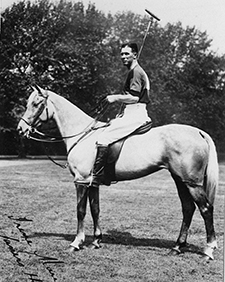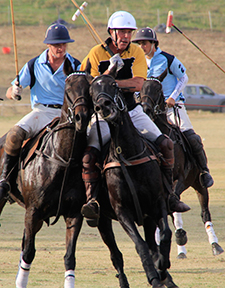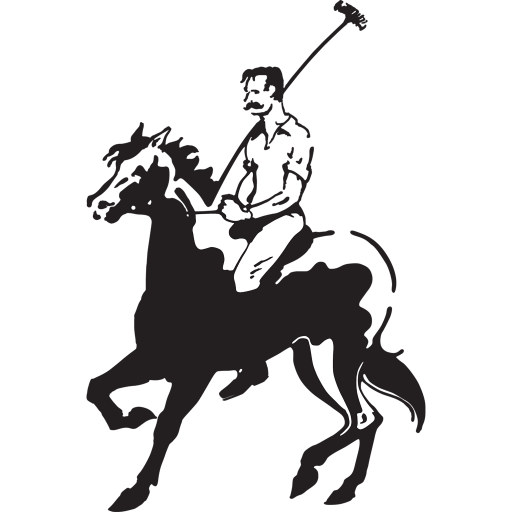

NOTES ON POLO BY JAMES HAY ASHTON
I wrote these notes in 1938 and found they helped very much to make four players into an effective team.
If the players comprising a team were not thoroughly experienced in each other’s play, I asked each player to read them carefully before each tournament game.
I have only studied two books on Polo, Modern Polo by Miller (English) and As to Polo by Foster (American). These books deal well with the very many aspects of the game such as hitting, training and riding the pony, combination, etc. On the question of hitting the ball, which is the most important thing in Polo, Devereux Milburn, the great Back, said: “The most essential thing is to hit from the proper brace of stirrups, knees and seat.” I also include Tactics of Play by Thomas Hitchcock Jnr, which are outstanding notes for all players.
TEAM PLAY
- Get to the line-up in plenty of time and position continuously to get closer than your opponent to the Umpire throwing in the ball, at the same time keeping close to him to prevent him breaking through quickly after the ball is thrown in.
- When the ball is thrown in No. 1 should make a great effort to hit it, and hit or missed go up as quickly as possible. No. 2 should also try his utmost to hit it for his No. 1 to take on but should remain in the line-out if he misses until he knows the ball is definitely out of the line-up. No. 3 should make every effort to hit a fore hander but, immediately he misses, must turn back without looking to see where the ball has gone. No. 4 should place himself to gallop in to hit it if the ball passes the No. 3, but must only do so if he has a certain hit at it or can definitely block the opposing Back getting it. If the ball stops or is hit by either side before passing the No. 3 he must turn back immediately and not look round till he has his pony moving back at pace towards his own goal.
- Don’t become a spectator of the game, keep your brain alert all the time and play your position.
- Play as hard as you can mentally and physically (and quick thinking saves your pony), never let up for a moment, don’t check if you think a foul has occurred, play until the whistle blows. Never give up trying till the ball is through the goal.
- When players are positioning or riding each other off in front of you, hit the ball to the side your man is on, not to your opponent.
- It should be the object of a side to ride their opponents away from the centre of the field and then hit to the centre so that their players can pick up the ball in a good position for scoring goals.
- It is generally good policy to let an opponent’s hit go behind rather than hit at it, if you are hard pressed.
- Watch your corresponding opponent continually, so that you can ride him out of position to get the ball always on defence and often on attack. Manoeuvre unceasingly with this in view. It is all important.
HITTING OUT FROM BEHIND
The No. 3 (or No. 4, as the case may be) must position continually to cover the man closest in if he is at all likely to meet the ball; if he can easily be avoided by the player hitting in, cover another man. The No. 2 should position just offside the next opponent likely to meet the ball; he should face towards his own goal to view the hit out. If the hit out is along the ground, he would gallop in to block his opponent meeting it, if it is long and lofted he should turn immediately to get away offside his opponent. In this position it is easier for the No. 2 to watch his opponent and the ball than for the opponent to watch him and the ball. The No. 1 has to use a lot of discretion as to where he positions. If the Nos. 1, 2 and 3 on the opposing side all look to have good chances of meeting the hit out, it is good policy to leave his opposing Back and stand just offside the opposing Nos. 2 and 3 and adopt the same tactics as for No. 2, always remembering that he must go up to the opposing Back immediately the hit out is under way or the opponent he is marking cannot immediately meet it. If only two of the opposing Nos. 1, 2 and 3 have a chance for the hit out to meet, stay with your Back.
No. 1 POSITION
No. 1 should be a great optimist. He should ride forward every time there is the slightest chance of his side getting on the attack; he must not wait to see the ball hit; he must get offside his opposing Back and often ride him out to the side on the chance that his own side will hit the ball up and, if the opposing Back rides back fast and deep, he must go with him hard even if both players get too far from the game for a time. If you get the opposing Back a long way out of the game it gives your No. 2 more chance to come fast on a run and hit a goal, and opportunities arise if you have your Back well covered for you to hit goals from in front, or drop in behind your No. 2 if he is ridden out and hit a goal from behind him. Remember always that the time you must turn quickly and come back to defend fast, is if you and your Back have ridden each other over his back- line. Your side will be backing up hard and fast to try and hit a goal. If you turn quickly when in this position you can cover the defence for your own No. 3 and Back, and enable them to gallop in fast with confidence to try and hit the goal, knowing that if they miss the ball the other side will not get clear away. Don’t rush the Back in forlorn hopes, but, if he really steadies on the ball or goes to turn on it, you must go to him at a collected gallop to force him to hit, and then mark him before he can get into another play. You can disconcert a Back by changing the pace of your pony quickly.
No. 2 POSITION
No. 2 must be the hardest worker in the team and have the handiest ponies. He must keep after the ball continuously on the attack and always be on the look-out to get breaks from rucks. His aim should be to position to pick up the fore-hand or back-hand shots of his No. 3 or Back and punch them on up to his No. 1 for the latter to try and carry on and score.
His aim should not be to make runs. He must generally keep well up and close to his opposing No. 3, endeavouring to out- position him, and always turn early, assuming a good back-hand hit from his No. 3 or Back. If, on attack, he is ridden over the ball or misses it, he must ride on and then look round quickly to see whether it is desirable for him to turn and cover his No. 3, who is backing up the run. The No. 3 cannot ride in with confidence for a fore hander unless he knows that his No. 2 is ready to cover him if he misses or gets hooked or ridden-off.
No. 3 POSITION
Keep your brain alert. Watch your corresponding opponent continually and ride him out. Manoeuvre unceasingly for positions that will enable you to meet balls and, if the opposing No. 2’s position makes that impracticable, take him out and get a back-hand! Don’t hit back-hands back into ponies. Always cut or drag them. Never go for risky meets or backing up of runs- unless your No. 2 can cover you, otherwise you often let two opponents on to your Back. Never turn up till the Back has hit the ball and you can see where it has gone. If you get into No. 2 position, do the opposite; turn early, assuming a good back-hand hit. When you cover your Back, cover fast and deep. Don’t let big hitting slow your game up. Be ready to turn up on your No. 2’s back-hands. Watch your opposing No. 2 continuously and ride him out.
No. 4 BACK
A good Back should position close enough to the game and at such angles to the game that he can enter easily on to the line the ball is most likely to be hit without crossing. The position of the opposing No. 1 will always influence what you can do in this respect and will generally make you play deeper than you would prefer. You must watch him unceasingly and ride him out before he can get in front of you, and then look for and try and hit the ball and, if you cannot get to it, you will have to depend on your No. 3 being able to get it. But, if your opponents are in possession, you must not let your No. 1 get offside of you. A good Back is one who continually positions so cleverly that he can cover the opposing No. 1 and get the majority of his back-hands without riding hard. This gives his forwards confidence to turn for his back-hands and conserves the pace of his pony for the desperate occasions when he has to race hard to save a goal or beat two opponents.
Do not hit your back-hands back into ponies, cut or drag them. You may steady your pony a little to hit your back-hand, but immediately you either hit it or miss-hit, ride on hard for some lengths before steadying or looking round to see where the ball has gone. If you fail to do this and your back-hand is met, the No. 1 may slip past you and score from the ball when it is hit up.
Always be ready to turn and meet a ball if your No. 3 calls you or you call on him to cover you. You get many opportunities to do this if you are playing reasonably deep. Always be ready to dive in to meet the ball if the opponents are hitting at goal.
Occasionally your No. 3 can bring you up with a wide-cut back-hand.
When you get up don’t hang around and speculate, start to get back as soon as possible, but if changing positions is undesirable for the moment, ride out your closest opponent.
The best and mostly the easiest time to regain your position is when your side gets on the attack and you and the No. 3 are only backing up.
Never meet a ball (except to prevent a goal), or back up a run, unless you can see that someone can cover you. It is too risky; let your opponent ride in and hit the ball and play for his shot. You must be a pessimist. If you get into No. 3 position cover the opposing No. 2 on defence and never turn up on the Back’s back-hander until it is hit and you see where it has gone.
